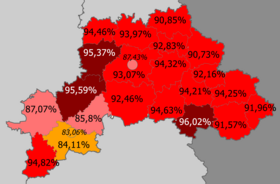|
Mogilev region
Mogilev region, also known as Mogilev oblast[a] or Mahilyow voblasts,[b] is one of the regions of Belarus. Its administrative center is the city of Mogilev. Important cities within the region include Mogilev, Asipovichy and Babruysk. GeographyWithin Belarus, Mogilev region borders Vitebsk region (to the north), Minsk region (to the west), and Gomel region (to the south). It has international borders with the Russian Federation (Smolensk Oblast to the east and Bryansk Oblast to the south-east). Mogilev region covers a total area of 29,100 square kilometres (11,200 sq mi),[3] about 14% of the national total. The region's greatest extent from north to south comprises 150 kilometres (93 mi), from east to west – 300 kilometres (190 mi), while the highest point is 239 metres (784 ft) above sea level and the lowest at 126 metres (413 ft) above sea level. Many rivers flow through the Mogilev region, including the Dnieper (Dniapro), Berezina, Sozh, Druts, Pronia and Ptsich. The oblast also has small lakes, the largest being the Zaozerye Lake with a surface area of 0.58 square kilometres (0.22 sq mi). The Chigirin Reservoir on the Druts River has an area of 21.1 square kilometres (8.1 sq mi). The extreme eastern point of Belarus is situated within the Mogilev region to the east of the Khotimsk District.[4] ClimateMogilev region has a temperate continental climate, with cold winters and warm summers. January's average temperature ranges from −8.2 °C (17.2 °F) in the northeast to −6.5 °C (20.3 °F) in the southwest. July's average temperature ranges from 17.8 °C (64.0 °F) in the northeast to 18.7 °C (65.7 °F) in the southwest. The region's average yearly vegetative period lasts around 183–194 days. The average precipitation is 575–675 millimetres (22.6–26.6 in) a year, with approximately 70% falling during the warm season (April–October).[citation needed] DemographicsWith a total population of 1,088,100 (2011),[3] 353,600 inhabitants live in rural areas and 855,000 live in cities or towns. There are 639,300 women and 567,300 men in the region, of which 288,100 are under 18 while 267,300 are elderly people. Of the major nationalities living in the Mogilev region, 1,044,000 inhabitants are Belarusians, 132,000 are Russians, 3,500 are Jewish, 2,800 are Poles, 2,110 are Ukrainians, 1,700 are Tatars, 1,300 are Lithuanians, 1,100 are Armenians, and 1,070 are Romani.
TourismThe number of travel agencies in Mogilev region has grown from 20 in 2000 to 50 in 2010, 12 of which provide agent services, the others are tour operators.[5][6] Mogilev region hosts 3-4% of all the organized tourist arrivals to the Republic of Belarus.[7] The most popular cities to visit in the region are Mogilev and Bobruisk. Administrative subdivisionsToday the region consists of 21 districts (raions), 195 selsovets, 14 towns, 3 city municipalities, and 12 urban-type settlements. Districts of Mogilev region The 21 districts of Mogilev region are:
Cities and townsPopulation of cities and towns in Mogilev region according to 2023 estimates.[8]
Consequences of the Chernobyl Nuclear Power Plant disasterDuring the elimination of the consequences of the Chernobyl disaster, as of 2010, residents of 141 settlements in the Mogilev region were evacuated, and 88 settlements were buried. In the post-accident period, more than 21,500 people were resettled to clean areas of the republic, leading to a decrease in the region 's population by about 7%. The most contaminated areas are the Bykhaw, Kastsyukovichy, Krasnapollye, Slawharad, and Cherykaw districts; these areas are contaminated not only with cesium-137, the main dose-forming nuclide, but also with strontium-90. In 14 districts of the Mogilev region, 11,200 km² of territory became radioactively contaminated: Byalynichy, Babruysk, Bykhaw, Kirov, Klimavichy, Klichaw, Kastsyukovichy, Krasnapollye, Krychaw, Krugloe, Mogilev, Slawharad, Chavusy, and Cherykaw district, which accounts for 38.6% of the total area of the region. At the beginning of 2010, nearly 119,500 people lived in 778 settlements in areas of radioactive contamination.[9] NotesReferences
External linksWikimedia Commons has media related to Mogilev Region.
|
||||||||||||||||||||||||||||||||||||||||||||||||||||||||||||||||||||||||||||||||||||||||||||||||||||||||||||||||||||||||||||||










